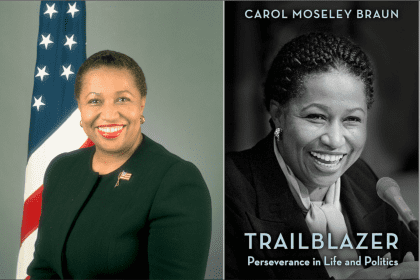
Earle C. Mitchell was inspired by African and African American history to write Egyptian Origins of Washington, D.C. Vol. 1: African Gods in America’s Capital. Read on for what he says about his journey to write the book.
What inspired you to write this book?
There are several things that inspired me to write this book. First, I have always loved African and African American history. As I got older I bought as many book on our history. At a point, I had amassed a considerable library of books on African and African American culture. One day, in a book store, I was looking for a book. I couldn’t find the book I was looking for and it was not as if I had any particular book in mind. An old college professor happened to walk in the store, [but] I did not see him. He ended [up] a few feet behind me and asked, “Mr. Mitchell, have you found what you’re looking for?” In that moment I told the professor no, but recognized that the book I was looking for was the one I needed to write.
Fast-forward a year or two and I am in Washington, D.C., for Harry Eversly’s, my great uncle, birthday party. While in Washington, D.C., I took my nephew, Marquis Ross, on a tour of the city and bought a map. I liked the map so much that I hung it up in front of my desk in my home office when I got back to Atlanta.
One day while looking at the map I thought to myself, “is that a map?” I took the map down, bought some tracing paper and took the results to a famous historian in New York. His name is Dr. Yusef Ben Jochannan. When I showed him my tracing he said, “This is good, but can you prove it?”
Those words, “… can you prove it,” lead me to go back to school to acquire a master’s degree in African American studies to prove my hypothesis. My master’s thesis was titled Understanding Washington, D.C. through a Kemetic Lens, and the rest, as they say, is history.
What is the central theme of the book?
The theme of the book centers around the Egyptian — Kemetic — ideas that are found within the urban plan of America’s capital city, Washington, D.C. Specifically, the books shows how three ancient Egyptian papyri set the foundation for how the street layout of Washington, D.C., was conceived. This is remarkable because most Americans have no idea these African elements from Egypt are there.
Is there something you are trying to espouse in the book?
Yes. I am espousing that fact that the African contribution in Washington, D.C., from ancient Egypt, is more than what we currently know. The Greco-Roman, Baroque and Parisian ideas found in America’s capital are discussed more frequently and have been chronicled. However, Egyptian Origins of Washington, D.C. Vol. I: African Gods in America’s Capital expands the agreed upon narrative about how the actual street layout came to fruition.
This is important because the African and African-American contribution to America is oftentimes under reported, omitted or given marginal exposure. This book expands the reader’s understanding of just how great the African and African American contribution has been. While we recognize the individual achievements of African Americans on America, it is a rarity to see how African thought has significantly affected the way the nation’s capital was constructed.
How did you approach this as a writer, what vision did you have?
I approached this project as a researcher who has a layman sensibility. As a researcher it is sometimes hard to allow your work to be accessible. However, the book is written with the layman in mind. Literally the book gives the reader the tools to tackle the amount of information shared. From explaining the meanings behind the ancient Egyptian symbols, to the application of African thought to the urban plan of Washington, D.C., the reader is given all the intellectual accoutrements to understand and participate in the book.
The vision maintained while writing the book was to give a very lucid understanding of the complexity of America’s capital city. The ideas presented are ancient and the manner in which these Egyptian ideas were implemented into the street layout is [and] was hard to see. Recognizing the ancient ideas of Egypt and the modern utilization of these ideas in America’s capital city opens up another level of cultural understanding.
How long did it take you to finish the book?
It took roughly a year.
Do you have any other subjects you plan to write about?
Yes. The next two books follow in the relative same direction. The second book is titled Egyptian Origins of Washington, D.C. Vol. II: The Sacred Feminine and How Washington, D.C. Births Knowledge and Law through the Sanctity of an African goddess. This book moves the Egyptian ideas in America’s capital further.
In this volume, the ancient resurrection story of Asr (Osiris), Ast (Isis) and Heru (Horus) are shown. The interplay between heaven and earth as this story is played out is shown etched into the urban plan of America’s capital.
Volume three, which is subtitled Planispheres of the Gods shows the readers where the original idea of Washington, D.C. can be found in Africa, today! Yes, you can see the original elements of where the street plan of Washington, D.C., came from. This is amazing because Pierre Charles L’Enfant said that the manner in which Washington, D.C., was laid out was “wholly new.” This volume shows how these purely African elements set the precedent for what would be the urban plan of America’s capital.
What message do you want to impart to readers?
I seek to impart to the readers that the contribution of African thought has left, and continues to leave, an indelible mark upon America’s capital city. Further, because we can see the specific ideas, potentially streets in Africa, as found in Washington, D.C., it can be implied that these ideas from Africa set the foundation for what would become the most famous republic in modern times. This can be said because there is a one-to-one relationship with what we see in Africa and what we see in Washington, D.C.
What books are currently on your nightstand?
The books on my nightstand are Dark Light Consciousness: Melanin, Serpent Power, and the Luminous Matrix of Reality by Edwad Bruce Bynum, Re-visioning the Earth: A Guide to Opening the Healing Channels Between Mind and Nature by Paul Devereux and The City Shaped by Spiro Kostof.
The last book that made you cry?
The last book that made me cry was Without Sanctuary by Hilton Als and James Allen.
The last book that made you furious?
The Bell Curve
Literary heroes?
There are many, but to name a few: James Baldwin, Fredrick Douglas, Drusilla Dungee Houston, Chiek Anta Diop, Theophile Obenga and Edward Bruce Bynun.
You’re hosting a literary dinner party. Which three writers are invited?
James Baldwin, Ptah Hotep and Niccolo Machiavelli.
And if you could bring only three books to a desert island, which would you choose?
The three books would be: SAS Survival Handbook: How to Survive in the Wild, in any Climate, on Land or at Sea by John Wiseman, African Philosophy by Theophile Obenga and As Serious as Cancer by Shaaryn A. Mitchell. That book, As Serious as Cancer was written by my mother detailing her fight with cancer.
Order Egyptian Origins of Washington, DC at www.3rdimedia.com. Click on the Egyptian Origins of Washington, DC link and acquire your copy today.










